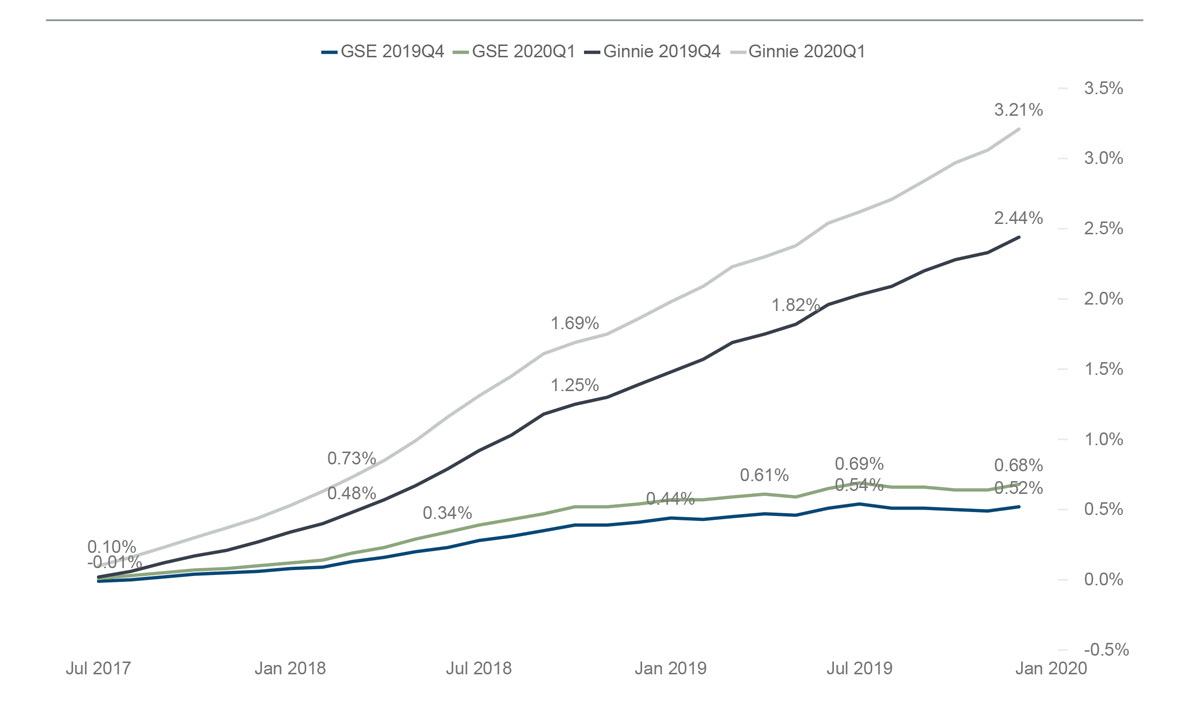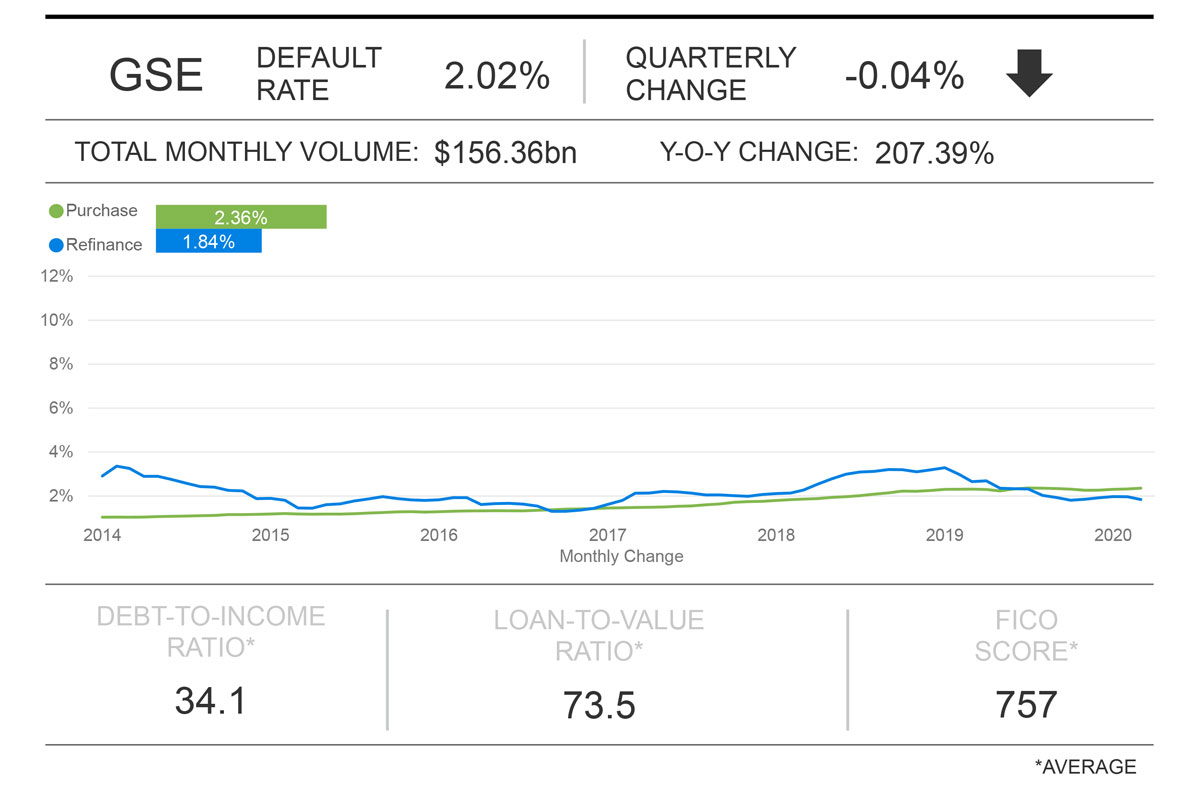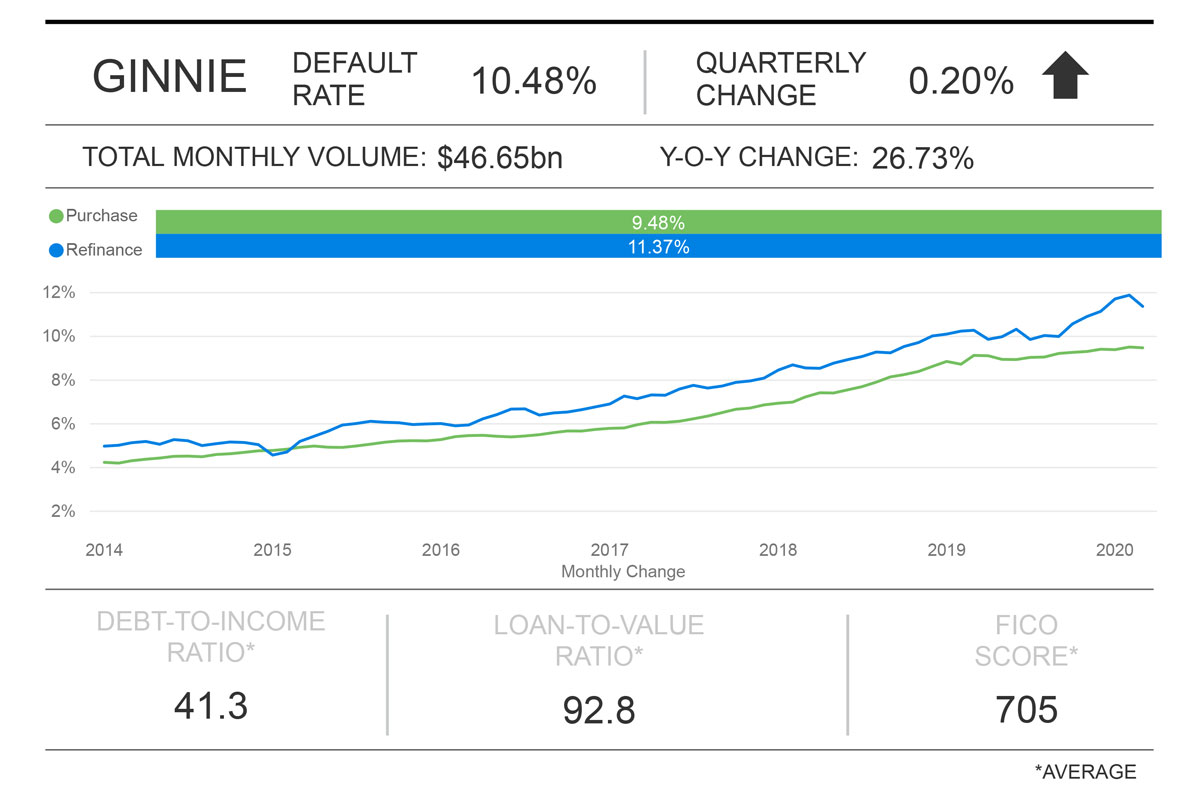The Milliman Mortgage Default Index (MMDI) is a lifetime default rate estimate calculated at the loan level for a portfolio of single-family mortgages. For the purposes of this index, default is defined as a loan that becomes 180 days delinquent or worse1. The results of the MMDI reflect the most recent data acquisition available from Freddie Mac, Fannie Mae, and Ginnie Mae, with measurement dates starting from January 1, 2014.
COVID-19 effects on mortgage risk
Interact with the MMDI

To explore the MMDI data on a more granular level, including loan origination and type, click here.
There is significant uncertainty regarding how mortgage performance may be affected as a result of COVID-19 and associated economic impacts. As of July 4, 2020, there were 17.3 million continued claims for unemployment benefits; this is up from an average of 1.7 million continued claims for unemployment benefits prior to the pandemic. As a result, we anticipate that the large number of unemployment claims will translate to an increase in mortgage delinquency rates. The economic and housing market slowdown resulting from the pandemic, in turn, could affect mortgage performance; however, it appears that claim rates will not be as severe as those observed during the global financial crisis.
The models used in Milliman’s MMDI analysis rely upon home prices to forecast default rates; they do not rely on unemployment rates nor do they have specific adjustments for special forbearance programs such as those introduced in the CARES Act, which could result in an increase in forbearance and delinquency rates. Adjustments have not been added to the models in response to COVID-19 because the models and index are designed to identify long-term trends on mortgage credit consistently across time. Further, the ultimate mortgage performance from delinquency to either cure or foreclosure/real estate owned (REO) is uncertain.
Historically, the transition rate from delinquency to claim has been driven by borrower equity. Given the robust home price growth experienced over the past several years, without sharp declines in future home prices, many delinquent borrowers are expected to cure from these delinquency events as they have equity in their properties. Milliman is actively monitoring and analyzing these trends to evaluate future mortgage performance in light of COVID-19.
Key findings: 2020 Q1
Past releases of the MMDI have focused on changes in borrower risk (i.e., the credit profile of borrowers) and underwriting risk (i.e., specific loan and property features that increase or decrease default risk) from quarter to quarter, with economic risk contributing to consecutive decreases in the index value as home price growth has been strong since the first publication of the MMDI. With the current pandemic, the economic forecast for home price growth has deteriorated relative to the economic forecast relied upon to produce the MMDI last quarter. The deterioration has led to an increase in default risk when reviewing the MMDI value across origination periods from quarter to quarter.
Figure 1 illustrates the change in the economic risk component from 2019 Q4 to 2020 Q1 for government-sponsored enterprise (GSE) and Ginnie Mae loans.
FIGURE 1: ECONOMIC RISK BY INVESTOR AND ORIGINATION
For 2020 Q1, the economic component of default risk for GSE loans increased by approximately 40% quarter over quarter (climbing from approximately 50 basis points to 70 basis points) as a function of a change in the economic conditions in the housing market, namely the expectation for home price declines over the next 12 months. For Ginnie Mae, the impact is larger given the higher level of borrower risk in Ginnie Mae loans relative to GSE loans. The economic component of default risk for Ginnie Mae loans increased from approximately 240 basis points for recent originations to 320 basis points.
Looking at total default risk (borrower, underwriting, and economic risk), the MMDI for GSE acquisitions (loans acquired by Freddie Mac and Fannie Mae) decreased slightly, lowering from 2.06% for loans originating in 2019 Q4 to 2.02% for loans originating in 2020 Q1. This is because, as interest rates continued to decline, lower default risk from refinance loans offset an increase in default risk for purchase loans. Figure 2 provides the quarter-end index results for these loans segmented by purchase and refinance.
The MMDI for Ginnie Mae loans increased from 10.29% in 2019 Q4 to 10.48% in 2020 Q1 as can be seen in Figure 3 (segmented by purchase and refinance). Beginning in 2014, Ginnie Mae has experienced a credit score drift relative to GSE. This shift has been the primary driver of this quarter-over-quarter increasing trend for Ginnie Mae loans. Additionally, for certain types of refinance loans, Ginnie Mae acquisitions do not receive an updated credit score. In the first quarter of 2020, these loans accounted for approximately 11% of Ginnie Mae acquisitions. For the MMDI, a credit score of 600 is conservatively used to calculate the default risk on mortgages with a missing credit score.
Agency summary
When comparing the most recent Freddie and Fannie acquisitions to the prior quarter, we see the continued trend of a decreased borrower and underwriting risk profile. This trend reflects the further decline in mortgage rates which continue to prompt refinance mortgages. For the most recent quarter, 60% of the mortgage volume was refinance loans. Refinance loans tend to have lower loan-to-value (LTV) ratios and lower debt-to-income ratios relative to purchase loans, thus the lower risk. However, when we factor in the upward pressure as a result of economic risk, which includes the projected impact of COVID-19, overall default scores have an upward trend. Our models estimate negative home price growth over the next 12 months, which puts upward pressure on mortgage default risk. If actual home price growth differs from these projections, the MMDI will adjust accordingly in future publications.
Figure 2 shows a summary of the latest MMDI segmented by loan purpose and filtered to GSE loans.
FIGURE 2: MMDI DASHBOARD FOR GSE LOANS
Loans guaranteed by Ginnie Mae experienced an increase in their default risk in 2020 Q1 driven mainly by increased economic uncertainty. Of the Ginnie Mae loans originated during this time period, 45% were purchase loans. For the remaining refinance loans, many were originated through streamlined refinance programs, where a credit score is not provided. These loans are conservatively assigned a credit score of 600 in the index, which increases borrower default risk during heavy refinance periods for Federal Housing Administration and Veterans Affairs.
The chart below summarizes default rates during the global financial crisis for a comparison of how rates look during an extreme scenario.
| Origination Quarter | Purchase | Refinance |
|---|---|---|
| 10/1/2007 | 1/1/2008 | 4/1/2008 |
| 16.76% | 14.25% | 13.01% |
| 11.52% | 8.64% | 9.17% |
Figure 3 shows a summary of the latest MMDI segmented by loan purpose and filtered to Ginnie loans.
FIGURE 3: MMDI DASHBOARD FOR GINNIE LOANS
Components of Default Risk
The components of the MMDI that inform default risk are borrower risk, underwriting risk, and economic risk. Borrower risk measures the risk of the loan defaulting due to borrower credit quality, initial equity position, and debt-to-income ratio. Underwriting risk measures the risk of the loan defaulting due to mortgage product features such as amortization type, occupancy status, and others. Economic risk measures the risk of the loan defaulting due to historical and forecasted economic conditions.
Borrower risk results: 2020 Q1
Similar to the prior quarter, borrower risk decreased across all investor and loan types during 2020 Q1 with the exception of Ginnie Mae refinance loans. With the decline in interest rates, we observed an increase in rate/term refinance originations. As borrowers refinance, they tend to do so at lower LTV ratios (with a cash-out refinance now being capped at 80% across all agencies), which reduces the credit risk of the underlying mortgages.
Underwriting risk results: 2020 Q1
Underwriting risk represents additional risk adjustments for property and loan characteristics such as occupancy status, amortization type, documentation types, loan term, and others. Underwriting risk after the global financial crisis remains low and is negative for purchase mortgages, which were generally full documentation, fully amortizing loans. In 2020 Q1, we have seen an increase in the percentage of refinance loans that are rate/term. This loan type has a lower risk profile relative to cash-out refinance mortgages.
Economic risk results: 2020 Q1
Economic risk is measured by looking at historic and forecasted home prices. Actual home price appreciation has been robust from 2014 through 2019, which has resulted in embedded appreciation for older originations. This results in reduced credit risk for older cohorts. For more recent cohorts, we have observed and continue to anticipate slower home price growth (or negative growth for some local geographies), which contributes to increases in economic risk for recent origination years. These trends increase as a result of the COVID-19 pandemic. This edition of the index forecasts zero to negative home price growth for the majority of states. Please read the disclaimer for COVID-19 for more context on economic risk.
About the Milliman Mortgage Default Index
Milliman is an expert in analyzing complex data and building econometric models that are transparent, intuitive, and informative. We have used our expertise to assist multiple clients in developing econometric models for evaluating mortgage risk both at point of sale and for seasoned mortgages.
The Milliman Mortgage Default Index (MMDI) uses econometric modeling to develop a dynamic model that is used by clients in multiple ways including analyzing, monitoring, and ranking the credit quality of new production, allocating servicing sources, and developing underwriting guidelines and pricing. Because the MMDI produces a lifetime default rate estimate at the loan-level, it is used by clients as a benchmarking tool in origination and servicing. The MMDI is constructed by combining three important components of mortgage risk: borrower credit quality, underwriting characteristics of the mortgage, and the economic environment presented to the mortgage. The MMDI uses a robust dataset of over 30 million mortgage loans, which is updated frequently to ensure it maintains the highest level of accuracy.
Milliman is one of the largest independent consulting firms in the world and has pioneered strategies, tools, and solutions worldwide. We are recognized leaders in the markets we serve. Milliman insight reaches across global boundaries, offering specialized consulting services in mortgage banking, employee benefits, healthcare, life insurance and financial services, and property and casualty insurance. Within these, Milliman consultants serve a wide range of current and emerging markets. Clients know they can depend on us as industry experts, trusted advisers, and creative problem-solvers.
1For example, if the MMDI is 10%, then we expect 10% of the mortgages originated in that month to have become 180 days delinquent or worse over its lifetime
Explore more tags from this article
About the Author(s)
Contact us
We’re here to help you break through complex challenges and achieve next-level success.


